Lake Michigan and Lake Ontario have large populations of king salmon and coho salmon. Lake Huron started stocking Atlantic salmon starting in 2013 and also has steelhead and lake trout. In Lake Erie, there is mostly steelhead but occasional coho salmon get caught.
This article focuses on catch freshwater salmon in the great lakes. If you are looking for the best salmon lures for catching salmon in the ocean check out this article on pacific salmon.
Salmon populations boomed in the Great Lakes since the early 2000s. Millions of salmon were stocked some years to combat an invasive type of herring called an alewife that was flourishing in the great lakes. More recently invasive mussels have been removing plankton that the alewife eats decreasing the alewife populations in some lakes. For this reason, stock rates vary from lake to lake and year to year.
Most salmon and steelhead are hatchery fish that are released as smolt. There is some natural reproduction and varies from lake to lake and stream to stream. The good news is that between, king salmon, coho salmon, steelhead, and lake trout there are usually great opportunities to catch trophy fish in the great lakes.
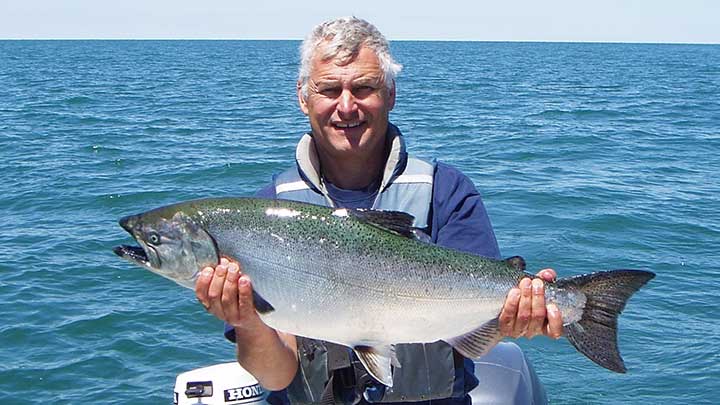
It took a while, but my dad and I mastered fishing for king salmon, coho salmon, and steelhead while trolling in Lake Ontario and Lake Erie. Catching salmon and steelhead in lakes close to where we lived seemed too good to be true. These are some of the largest fish that can be consistently caught in freshwater.
This information should be very helpful if you want to catch salmon and steelhead from a boat in the Great Lakes! My dad and I started trolling for steelhead in Lake Erie with moderate success. We would troll right by the mouth of the rivers in the fall with Little Cleo’s and generally catch a few steelhead on an average day and catch a dozen steelhead on a good day.
Then we heard that people catch big Chinook salmon, which are called king salmon if they are over 20 pounds, in Lake Ontario and started taking things more seriously. We would drive to Olcott or Oak Orchard Creek in New York and stayed there for a few days at a time. The first time we went up we did not have much luck. After that trip, I found out that my friend Jory Giger worked as a mate on charter boats at Oak Orchard Creek. He went out with us and our luck changed quickly! Jory taught us what we needed to know. One thing I will always remember is that when the downrigger line releases the slack in the line needs to be reeled up as quickly as possible! Jory would reel the slack up super fast and that makes it all the more fun when a fish bites!
My dad also learned that for the salmon derby tournaments each boat needed to have a neutral observer. He volunteered to be the observer for several tournaments and got to see several professional fishermen’s tricks to catch loads of Chinook salmon! It was not long before we could catch 20 fish a day between the Chinook salmon, coho salmon, steelhead, and lake trout. We were just fishing for fun and released all the fish caught. This means we can never reach a fish limit for the day!
The basic key to success is choosing the correct lures and having lots of poles out that are set at a variety of depths. Eight poles out would be ideal for an average boat! Four poles out on two downriggers, two poles using Dipsey Divers out the sides, and two more lines on the planner boards fishing shallow water. Eight poles out on an 18-foot boat is quite the experience! Four or more people need to be on the boat to run this many lines. In the ocean, each angler can typically only fish one pole. However, in the great lakes, each angler can fish two poles. If two people are on the boat only four poles can be used while trolling, which is limiting but still catches fish.
Here are the best salmon trolling lures for the great lakes.
1. Dreamweaver and Northern King Spoons
Dreamweaver and Northern King spoons are different spoons but are very similar. The standard size for both is 3-3/4 inch and the weight is 1/2 ounce but these do come in various other sizes.
There are many many different color patterns as well. Alewife silver black, Traders Back Magic, and Natural Born Killer are awesome spoon colors. Using spoons is the most popular way to catch salmon in the great lakes. Dreamweaver spoons outfish all the other spoons when it comes to catching king salmon. Dreamweaver and Norther King spoons have been more difficult to find in recent years. I think the companies have been in and out of business. Stinger spoons are lighter spoons but are the next best thing.
Dreamweaver and Northern King spoons are considered heavy spoons. Typically salmon trolling speeds are from 2 mph to 3.5 mph. These spoons perform best around 3 mph. We run black and white down deep on the down-riggers and brighter colors at shallower depths. A good distance of line to run behind the downrigger ball is 5 feet to 15 feet. These are “heavy” spoons but we rarely run these without a downrigger, Dipsy or jet diver. Orange Dreamweaver spoons work great at shallow depths for salmon and steelhead. However, we have better lure options to run on the planer board lines.
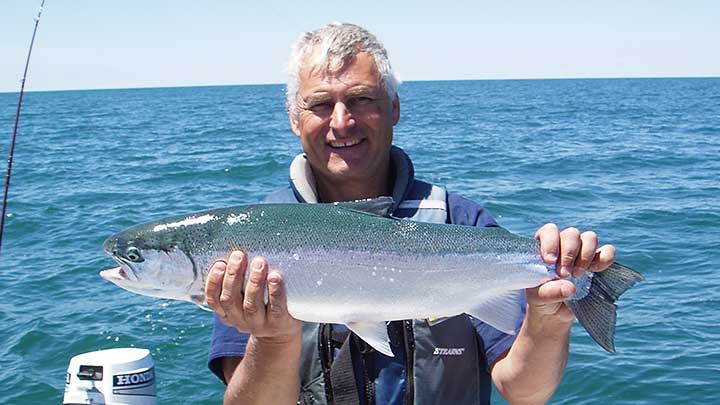
In the picture, my dad is holding a steelhead that he caught in Lake Ontario. This was caught while trolling with an orange J-9 Rapala on a planer board. We were also trolling with lines deep for king salmon. That is why it is important to set lines deep and near the surface when trolling in the great lakes.
2. Pro-Troll Flasher with Fly
Pro-Troll flasher with EChip. This flasher is 8-inches longs and comes in a variety of colors. The flasher in the picture is chrome green.
The flasher rolls in the water and this looks like a salmon feeding and attracts and excites salmon that see the flasher. A flasher with a fly works great for king salmon and should typically be sent below 60 feet in depth. The fly should match the flasher and the best color depends on the conditions but we typically use green flashers with ultra-violet or green or flies.
Ace Hi Fly By Silver Horde
The ace-high fly is 4-1/2 inches long and has a double glow head. This fly in the picture is the ultra-violet color which reflects great underwater and works great behind any color flasher.
Salmon Leader with Hooks
If you do not know how to tie double snell knots then you should buy a leader for the fly. Just cut the leader to about 32 inches and tie it to the flasher with your favorite fishing knot. You can get away with rigging the fly with one hook but having two hooks definitely helps the bite to catch ratio. I would recommend the 40-pound solid tie rigs to use with the fly. Three rigs come per pack.
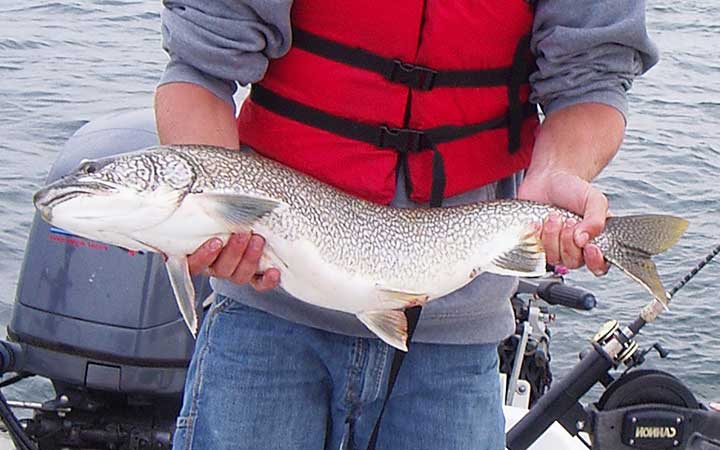
In the picture, I am holding a lake trout that was caught in Lake Ontario. This was caught very close to the bottom in 120 feet of water. The lake trout were caught using a black and silver Dreamweaver spoon.
3. Flasher and a Hoochie
The large hotspot flasher is 11-inches long and the medium hotspot flasher is 8-inches long. I would recommend getting the 11-inch flasher. It comes in a very large variety of colors. For the great lakes, green haze UV and chrome-mylar are great color options.
Salmon Hoochie
The Boone ultra-violet green haze hoochie is 4-3.4 inches long. This hoochie comes pre-rigged with double solid tie snelled hooks. Run this behind a Green haze flasher and you have one of the best flasher fly color combos for the great lakes.
Salmon Hoochie Fly Combo
The Luhr Jensen flash fly is 4-1/8 inches long. It is called a fly but is more like a hoochie fly combo with both a flash skirt and rubber hoochie material. This is a great option to run behind flashers and comes pre-rigged ready to go fishing.
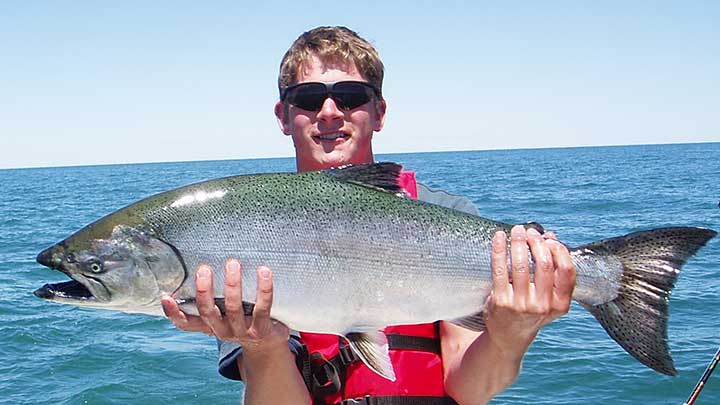
In the picture, I am holding a king salmon that was caught on Lake Ontario. This fish was caught on a green pro-troll flasher with and an ultra-violet fly while trolling deep with downriggers.
4. Orange J-9 Jointed Rapala for Coho Salmon
Gold Fluorescent Red J-9 Jointed Rapala plug. This J-9 plug is 3-1/2 inches and has a white stripe on the bottom.
A random customer at a bait shop suggested this lure to me and boy am I glad he did. What he called an orange J-9 jointed Rapala works magic on coho salmon and steelhead near the surface. This plug should be set far back behind the boat, really far back, the line is only to far back when there is no line left on the reel or when a turn is made and all the lines cross.
Actually setting the line 250 to 500 feet back is good. This outproduces any other spoon on lines running near the surface on planer boards. I know this works great in Lake Ontario and I want to try it in Lake Erie for Steelhead but have not got a chance to yet. I have caught pink and coho salmon in Alaska on the J-12 version of the plug which is slightly larger.
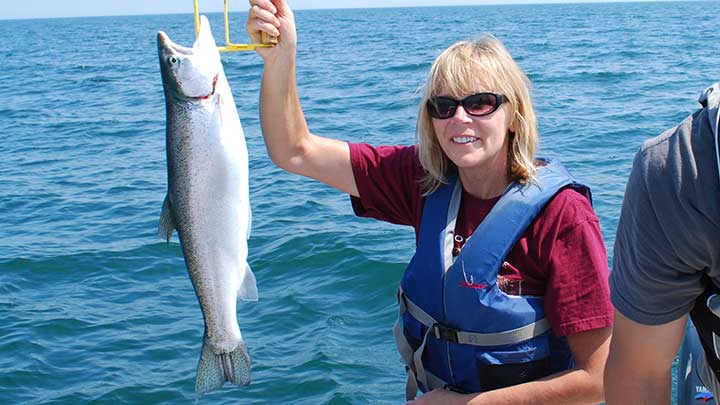
In the picture, my mom is holding a steelhead she caught in Lake Ontario. This was caught on a line set near the surface using a planner board.
5. Little Cleo Spoons
I really like the Acme Little Cleo Spoons. This is a short spoon only 2-3/8 inches for the 3/4 ounce spoon size that we typically used for trolling. Little Cloe’s come in sizes ranging from 1/8 ounce all the way to 1-1/4 ounces.
Little Cleo spoons are great for trolling for salmon and steelhead near the surface. Because Little Cleo’s are heavy spoons they can be trolled behind the boat without a downrigger, Dipsey Diver or jet diver. They certainly can also be used in combination with those devices. We typically run these straight out the back or on planner board lines. These come in a standard smooth finish and in a hammered series that gives a great texture to the spoon and looks like fish scales.
My go-to colors are purple-black or blue-green in the hammered series and Gold Fluorescent Stripe in the standard series. The amount of line out will control the depth but we typically run these 200 feet or more behind the boat. This will still be fishing for fish near the surface and the lure probably does not go deeper than 15 feet or so at a typical 3.o mph trolling speed.
6. KO Wobbler
The KO Wobbler runs very similar to Little Cleo spoons. They have slightly different action and vibrations than other spoons so it is worth having something a bit different out that also consistently catches fish. These run a bit deeper which is another reason to have different types of spoons out. They are still sent straight out the back or on the planer board lines.
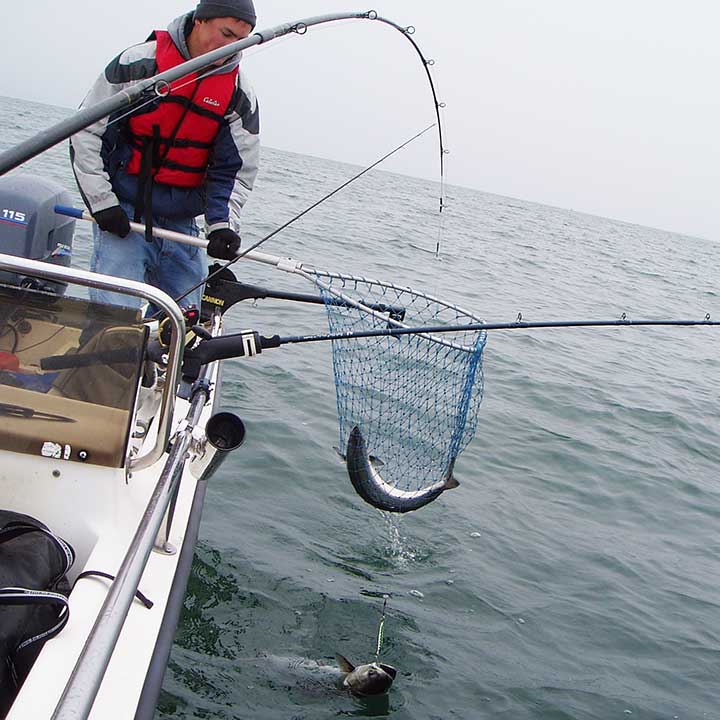
In the picture, I am netting a coho salmon in Lake Ontario that we caught on a line set near the surface. We also caught a king salmon on a Dreamweaver Natural Born Killer (NBK) spoon. It is not uncommon to catch more than one fish at a time. Notice the salmon fishing reel with a line counter.
7. Stinger Spoons
The Stinger Stingray spoon is 4.25 inches in length. The Glo Alewife and Natural Born Killer are great color options for king salmon. This is a light spoon that can be trolled slow 1.8-2.5 mph on lines set deep on downriggers. This is a glow-in-the-dark lure.
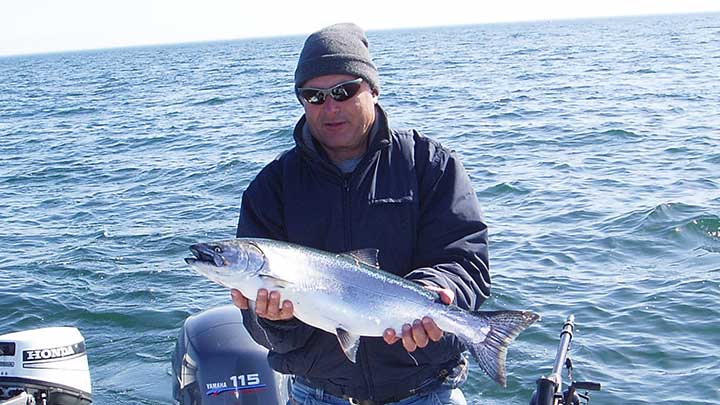
In the picture, my dad is holding a king salmon that he caught while trolling with a downrigger on Lake Ontario.
8. Blue Coyote Spoon
The Blue Coyote spoon comes in standard sizes of 3.5 and 4 inches. This spoon is popular for fishing on the west coast in the pacific ocean. Many great lake lures and tactics work for ocean salmon and this lure will work for coho and king salmon in the great lakes.
This is a lightweight spoon and can be trolled slower than the Dreamweaver spoons. It can be used behind a flasher or ran independently on downriggers.
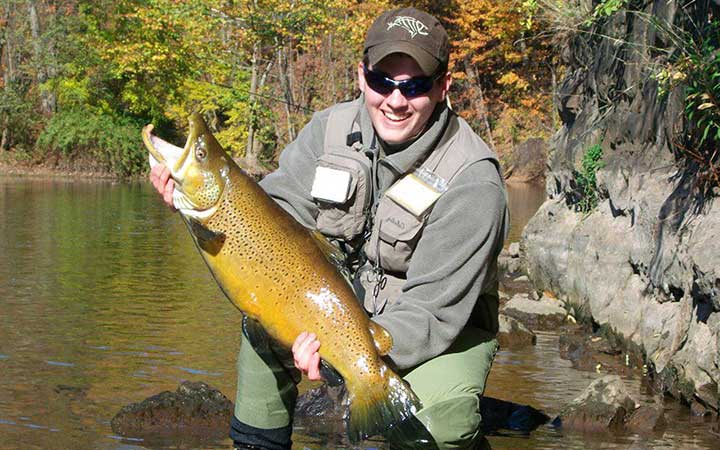
In the picture, my friend Justin is holding a nice brown trout that he caught while fishing in a stream that flows into Lake Ontario. He was also fishing for salmon and steelhead.
9. Egg Sacks and Minnows for Stream Fishing
Now let’s talk about how to catch salmon and steelhead in rivers, streams, and creeks. Unlike in most streams of the pacific northwest bait and minnows can be used when stream fishing near the great lakes. This is a huge advantage and is what I would recommend using. Bait is fished very similar for salmon as it is for trout with small hooks and floats. Eight-pound fishing line with 6-pound fluorocarbon leaders is the standard setup for salmon and steelhead fishing in rivers.
Salmon and steelhead fishing starts to get good in late September. The first large amount of rain will start to bring in large numbers of fish from the lake. High river flow rates above 100 cubic feet per second are good for salmon fishing in streams. Flow rates over 700 cubic feet per second are bad because the water turns brown and is not fishable. There are stream gauges that can be found online that can be checked before going fishing.
Most tactics and lures that work for trout fishing like spinners, flies and jigs also work for salmon and steelhead fishing. Check out the trout lures page for more information.
Salmon and Steelhead Fishing Egg Sacks
The salmon eggs sacks are about eight salmon eggs packaged together in a mesh netting material. There are six egg sacks per jar. The hook is secured in one egg. The sacks can be fished weightless, with a small split shot above the bait or with a small foam float. In streams, it is common to fish with a freshwater spinning reel.
Salmon and Steelhead Hooks
Small hooks size 6, 8, 10 or 12 are typically used for salmon and steelhead. With size 6 being the largest. I would recommend using a size 10 with live bait and eggs. Using a baitholder hook would be a good idea with eggs as well. The gamakatsu octopus hooks are similar to single egg hooks and are very popular hooks to use for salmon and trout fishing.
Salmon Float
These small foam floats work perfectly to suspend the bait just above the bottom while drifting the bait downstream. The float also serves as a strike indicator to know when the fish bites. Streams can be crowded so always be mindful of where the bait is drifting.
Salmon trolling techniques for the Great Lakes, Downriggers and Planer Boards
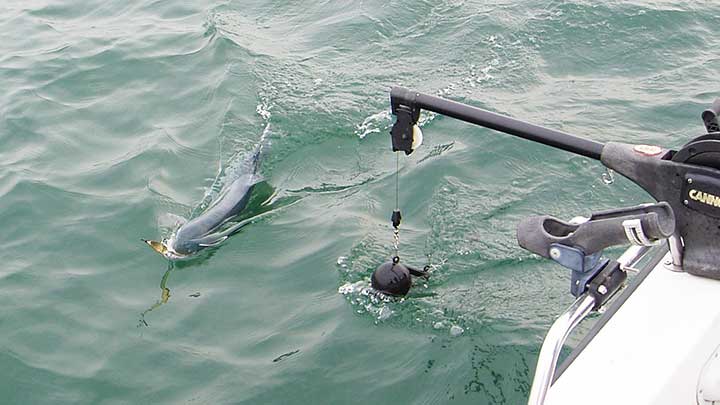
In the picture, a coho salmon is being reeled in that was caught on a spoon in Lake Ontario. The fish was caught while trolling with a manual downrigger.
Boat planer boards are used to run surface lines away from the boat similar to an outrigger on the big offshore fishing boats. Planner boards can actually get the line further out than outriggers. The planer board needs to be attached to the boat with a rope that is commonly connected with a planner reel. The fishing line is attached to the rope using release clips that can slide down the line.
Planer boards are a great way to get one or two lines far out on each side of the boat. This is especially important when fishing for steelhead and coho salmon that are typically in water depths near the surface during the fall salmon season. Having the lines set off to the side makes it so the boat does not scare the fish and if it does it will move the fish to the side where the lures on the planer boards are being trolled.
These plastic planer boards are the right size to get lines off to the side of the boat even in wavy conditions. Each planer board is connected to an elevated reel that has 200 feet of 200-pound braided line or rope. Fishing poles are set the desired distance behind the boat and then attached to a clip that is allowed to slide down the planer line as more line is released from the fishing pole. This can be done with one, two, or three poles on each side of the boat. This allows a much wider area to be fished while trolling which greatly increases the chance of catching fish! Typically lines are set 100 to 300 feet to the side of the boat.
Downriggers
Having at least one downrigger is a must when fishing for salmon. King salmon and lake trout are typically below 60 feet and are frequently caught in the 60 to 200-foot range. Using downriggers takes the guessing out of what depths are being fished. A line counter on the downriggers shows the depth of the ball. The depth of the ball can also be seen on the fish finder when the ball is set shallow or when trolling slowly. The depth should be adjusted to be 3 to 15 feet above the fish. The blowback of the line does need to be taken into account when determining the ball depth. Typically the actual depth is about 90 percent of the line counter depth. A spoon, plug or flasher with a fly are typically set 3 to 15 feet behind the ball.
Getting as many lines set at different depths is critical when fishing in the great lakes because fish are frequently found at different depths. Coho salmon and steelhead are typically found between the surface and 60 feet. King salmon and lake trout are typically found from 60 feet to the bottom. The overall water column depth generally being fished is from 50-250 feet.
Other ways to get lines set deep include using dipsey divers, jet divers, or lead core line on salmon fishing reels. Depending on the trolling speed and amount of line set out will determine the depth of the bait. Dipsey divers bring the bait deep and to the side of the boat which can allow more water to be fished. These techniques are good ways to fish up to about 80 feet deep.
Captain Cody has worked on charter fishing boats in the Florida Keys, Virgin Islands, and Alaska. Growing up in Pennsylvania Cody has also done extensive freshwater fishing including bass fishing tournaments. Cody strives to provide detailed information about the best fishing gear and tactics to help both novice and experienced anglers have a more productive and enjoyable time on the water. Cody also has a background in aerospace engineering and neuroscience but really only takes pride in being good at one thing and that is fishing!

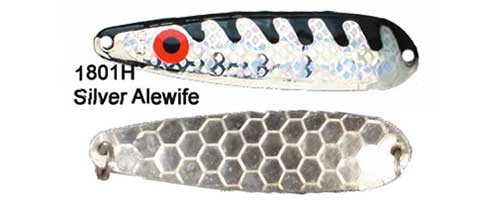

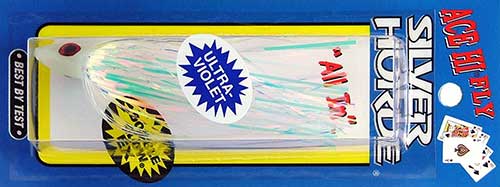
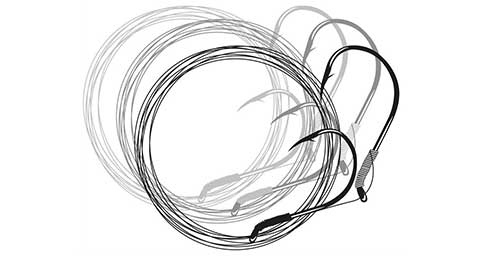
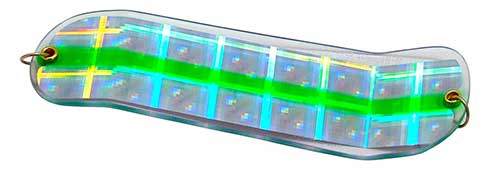
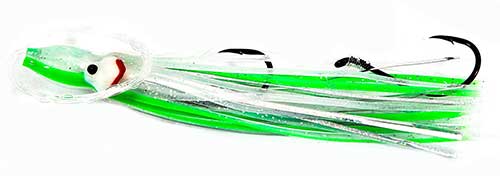
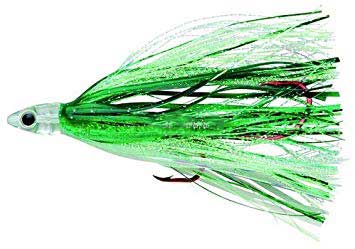

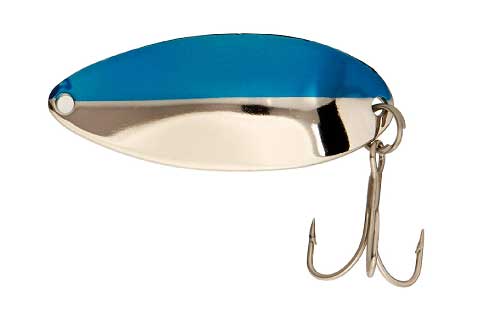
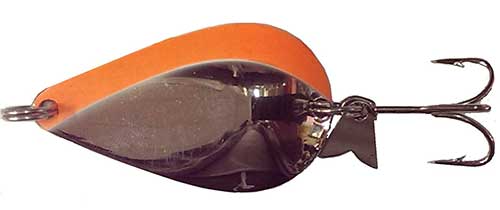
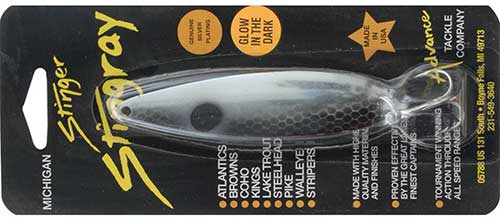

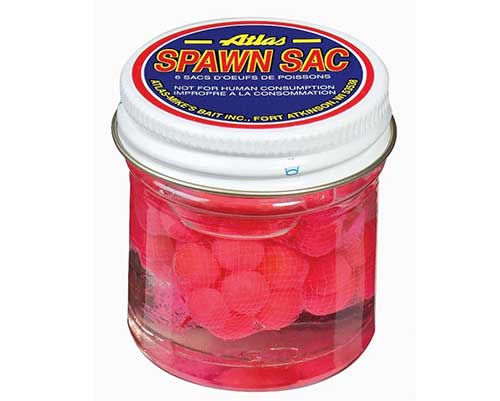
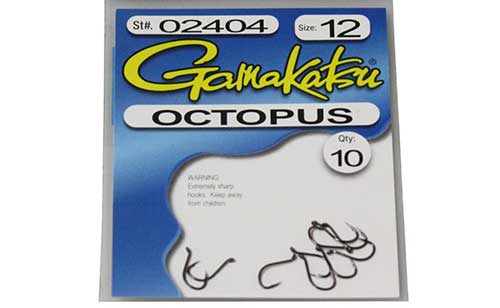
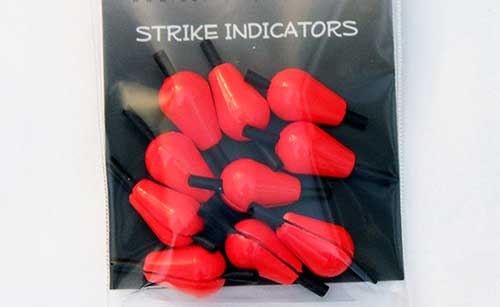
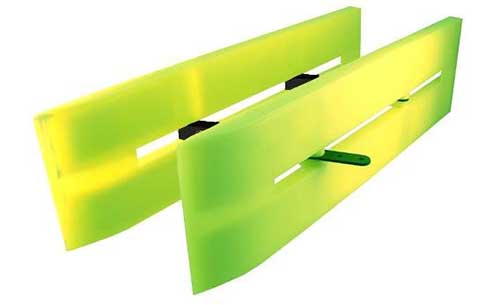
I typically don’t do very well at all on downriggers. I fish the Indiana part of lake Michigan up to about 120 foot. Any tips on running downriggers? I usually run 4 dipsys and 2 planers but would like to use my downriggers more often.
I read your article about the 9 best lures to use for trolling in Lake Ontario. You mentioned about the little Cleo spoons 3/4 ounce length 3 3/8 well the 3/4 ounce does not come in the length of 3 3/8 it comes only in 2 1/2 in. Am I missing something?
Thanks for the comment, you are correct the 3/4 ounce is 2-3/8 inches. I corrected the listing.
Great information. Thank you
My son and I started salmon fishing out of Georguanbay last year.
Sadly we did not catch one fish all year.
Hopefully, with this information we will have better luck this year.
Yeah, good luck fishing next year! These lures will definitely catch fish if they are around. If you know what streams the salmon swim up, do venture to far from the entrance of the streams in the fall. No more than a mile or so away is a good place to start. I think there are supose to be lots of atlantic salmon and steelhead up that way.